
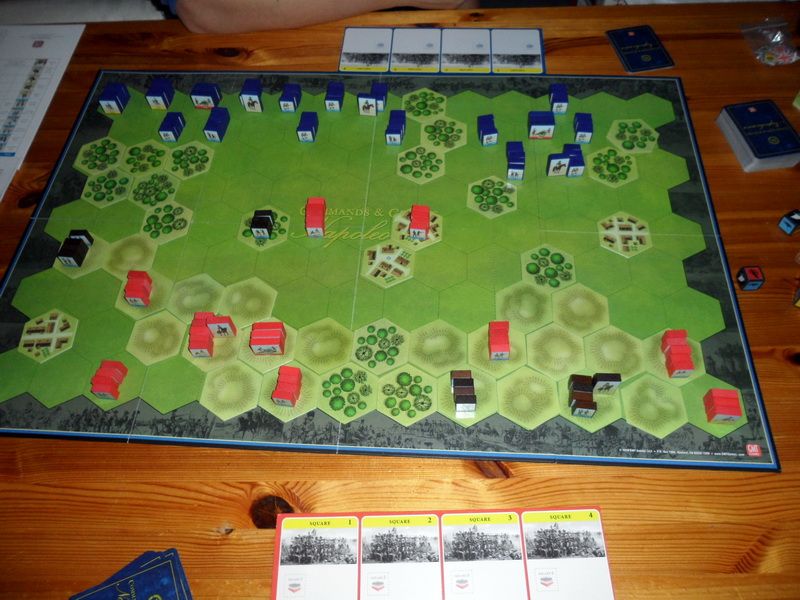 Played Commands & Colors: Napoleonic’s over at my friend Thomas house yesterday. Commands and Colors, if I understand it correctly, started the whole series of spinoff games using the same or similar gaming system.
Played Commands & Colors: Napoleonic’s over at my friend Thomas house yesterday. Commands and Colors, if I understand it correctly, started the whole series of spinoff games using the same or similar gaming system.You have a hexbased board, which is divided into 3 sections, and by using command cards you and your opponent take turns in activating units and battle it out. The combat system in these games is based upon rolling dice covered in symbols matching the various units of the game (infantry, artillery, cavalry) as well as a "Retreat symbol" and a symbol that always counts as a hit. Terrain features often offer a defensive bonus to the unit standing inside it. It's a simple but elegant system.
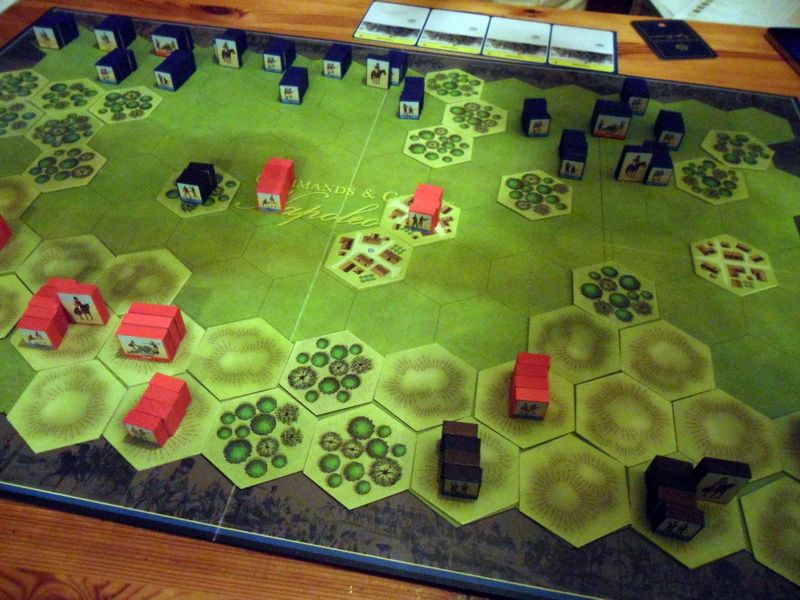
 The Napoleonic version of Commands & Colors comes with a rulebook, a campaign book and reference sheets. The campaign book as you may imagine includes various Napoleonic battles - the boxed set covers the British, Portuguese and French army only so the battles revolve around those 3.
The Napoleonic version of Commands & Colors comes with a rulebook, a campaign book and reference sheets. The campaign book as you may imagine includes various Napoleonic battles - the boxed set covers the British, Portuguese and French army only so the battles revolve around those 3.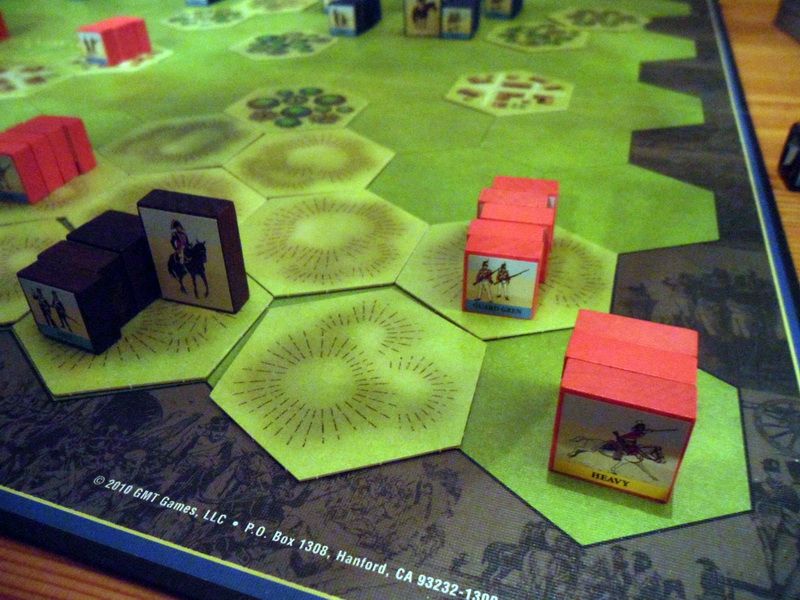
Each battle has instructions on how to place terrain (hills, rivers, towns and woods), how many regiments each player has and of what type, where these are deployed and the number of command cards each player has access to each turn.
 So what makes this game stand apart from the rest being "Napoleonic’s" themed? Mainly 3 things from what I could see during my game with Thomas.
So what makes this game stand apart from the rest being "Napoleonic’s" themed? Mainly 3 things from what I could see during my game with Thomas. First, there is a wide variety of infantry units, Line, Light, Light with rifles, Militia, Grenadiers, Guard Grenadiers. There are also a couple types of cavalry and artillery. Each nation has different tweaks to these standard units, but in general the British are better at shooting and the French are at better performing charges and hand to hand combat.
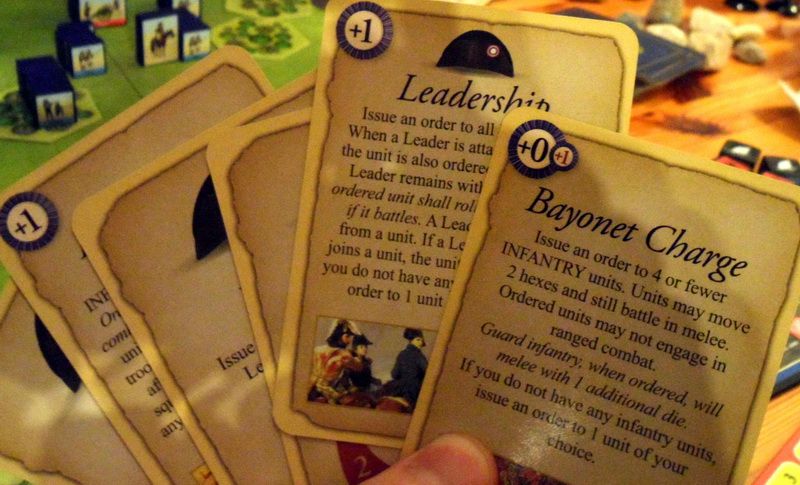
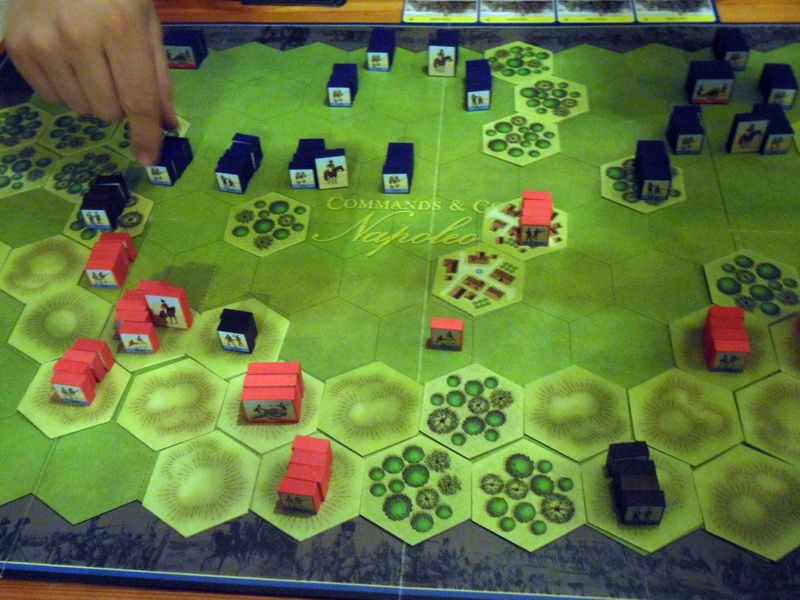 Second, the game includes commanders that help you ignore "Retreat" symbol inflicted upon your unit if a commander is attached, and the game also encourages players to keep a tight formation of units so that they can benefit from a friendly battle line which also improves morale.
Second, the game includes commanders that help you ignore "Retreat" symbol inflicted upon your unit if a commander is attached, and the game also encourages players to keep a tight formation of units so that they can benefit from a friendly battle line which also improves morale.Finally, there is the "Form square" formation which you can perform with infantry, which efficiently bounces cavalry units but which forces you to "lock" one randomly selected of your command cards for the duration of a unit standing in square formation. You can only have up to 4 units in a square formation, and the more you have the smaller your hand of command cards becomes and your ability to move troops with it.
 Anyone who has played Battles of Westeros or Memoir44 will be at home in this game and be familiar with many game mechanics and it’s hard for me not to make comparisons to those other games (the only one I still need to play is Battlelore).
Anyone who has played Battles of Westeros or Memoir44 will be at home in this game and be familiar with many game mechanics and it’s hard for me not to make comparisons to those other games (the only one I still need to play is Battlelore).If you compare C&C:N to Memoir44 then C&C:N is a better game. They are in many ways identical, with the board divided into 3 sections and reliance upon command cards. Though C&C:N has a bit more finesse a wider variety of units and actually feels better themed than Memoir44 which I just think is a very generic game with zero thematic relevance to WW2 if you took away the names of the command cards. Other than that you have the same type of commands, Recon in force, probe left flank with 1 unit, etc and both games use D6 dice.
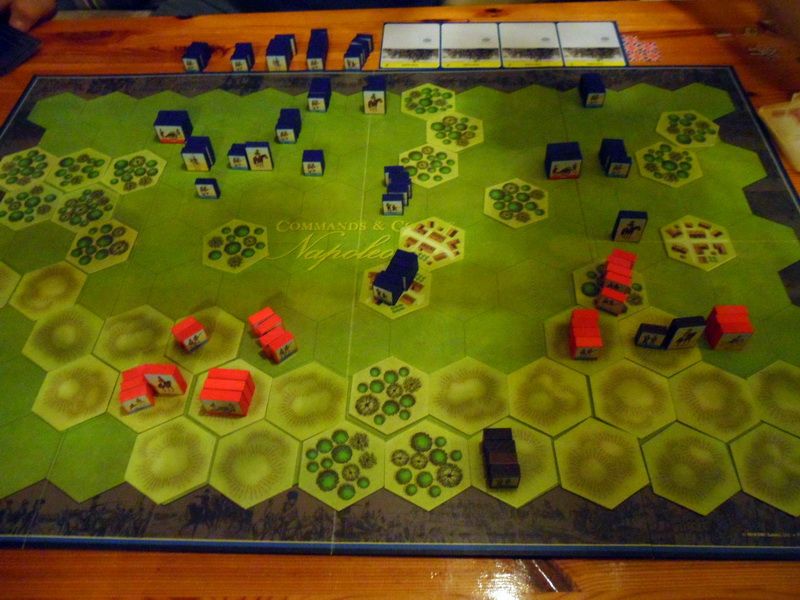 Compared to Battles of Westeros C&C:N is more stiff and old fashioned. Battles of Westeros does not have 3 zones and the command cards where you issue orders to units in those zones as you do in C&C:N and Memoir44. Instead BoW has an open board and rely on using battlefield commanders in close proximity to your troops in order to use command cards to move units about. In BoW it is also possible to move units out of command coherency by spending markers with the same color/rating as a unit you want to activate. And while the combat is very similar to the other two games, BoW makes use of D8 dice instead of D6. BoW is at the end of the day more focused on your commanders and them being able to lead troops with their presence rather than letting command cards decide which flank of the board and how many units with that flank gets to activate.
Compared to Battles of Westeros C&C:N is more stiff and old fashioned. Battles of Westeros does not have 3 zones and the command cards where you issue orders to units in those zones as you do in C&C:N and Memoir44. Instead BoW has an open board and rely on using battlefield commanders in close proximity to your troops in order to use command cards to move units about. In BoW it is also possible to move units out of command coherency by spending markers with the same color/rating as a unit you want to activate. And while the combat is very similar to the other two games, BoW makes use of D8 dice instead of D6. BoW is at the end of the day more focused on your commanders and them being able to lead troops with their presence rather than letting command cards decide which flank of the board and how many units with that flank gets to activate.If you want to talk components Commands & Colors: Napoleonic’s looks very old school. Despite being released just a couple of years ago the rulebook, board and terrain tiles all look as if they were from the 80's or something. It's very stripped down in its art direction. Units are made out of wooden cubes onto which you have to glue unit symbols (front and back), you also have to glue all the combat symbols on your D6 dice - and there is a ton of unit cubes in the box! And while they look nice and do the job I just can't imagine the pain in the ass job of applying hundreds of stickers.
However, as a Battles of Westeros owner, I personally hate the loose flags on the BoW units which you have to change between battles and dismantle after each game (and the fact that you had to glue all models to their base). So no game is perfect I guess when it comes to prepping it for play.
All of these games are easy enough to get into, are quite fun, and I do recommend them. The choice of game I guess depends on your age and thematic taste. Personally, if I had to choose between Memoir44 and Commands and Colors: Napoleonic’s (since these two are very similar) I would go with the later because it offers more units, interesting tweaks to the relatively simple rules and a more prominent theme.
No comments:
Post a Comment